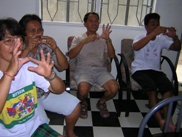| A Catalyst for Community Partnering Finding Institutional Partners Recruiting and Training Community Researchers Conducting Research with Community Members Presenting Research Findings Sustaining Partnerships |
Recruiting Community ResearchersCommunity researchers are people who share the experiences of the most economically challenged members of the local community. They are key to the success of Community Partnering. They may be people with little formal education but who are interested in learning new skills and who care for the future of their community. In poor rural areas of Asia community researchers might be unemployed youth, elderly people, underemployed labourers, part-time farmers or fishers, mothers with small children. In more urban areas they may be older workers who have lost their jobs, young people, immigrants or people from minority groups. Anyone can be a community researcher as long as they:
The primary qualification of the community researcher is to be able to connect with those who usually have no say in how the economy works. Depending on the context, enrolling community researchers can occur by:
Be wary of gate-keepers Gate-keepers are officials or activists linked in to established networks who claim to speak on behalf of others, especially marginalized people. They often have decided views about the capabilities of others and feel in a privileged position to know what others need. They are people with public reputations and allegiances to special interests. Because of this they are interested in partnership that will serve their constituencies. Community researchers need to feel free to establish new relationships and forge new partnerships. They are the ones who will help to unleash new possibilities. They cannot do this if they are too closely aligned with established interests. Community researchers will need to work through gate-keepers, but they will not be gate-keepers. Training Community ResearchersThe training of Community Researchers involves introducing them to the guiding ideas of Community Partnering and then helping the new researchers to communicate and use these ideas. First the Community Researchers will have to learn to work as a team. This means getting to know each other and learning to respect the different contributions each can make. It is useful to conduct some introductory exercises that get people to reveal themselves and appreciate the differences and similarities in the group.
Idea 1: Shifting from Needs to Assets Do the needs and assets mapping exercise with the Community Researchers. This should be done as a brainstorm as outlined in Assets Mapping. Idea 2: Building on existing community economic practices This training asks the Community Researchers to draw on their local knowledge about what sustains lives in their community. Get the group to do the Yesterday Survey and review the results. Use the ice-berg image to introduce different visions of the economy and get the Community Researchers to brainstorm the activities that are above the water line and those that are below.
During this training all the local names for different economic activities can be recorded and discussed so that when working with other community members it will be easy to illustrate what economic diversity means. Idea 3: Community members as action researchers This training introduces the difference between traditional research and action research.
Idea 4: Growing community enterprises
Idea 5 Accessing partners Community researchers often lack the confidence to seek out help from institutional partners. The best training they can have is for them to meet representatives of local government, NGOs, and other local institutions to discuss how partnerhips can be established. Often all that is needed is an introduction. Sometimes there is a need for coaching in how to set up meetings and prepare information to be presented in meetings. Role plays can be a good way of building up confidence. |


